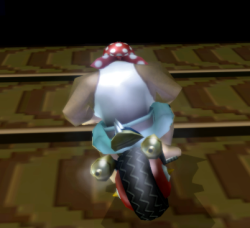Wallclip: Difference between revisions
Created page with "{{distinguish|supergrinding|supersliding}} {{Infobox strat |image=supergliding.png |other_names= |class=Glitch |type=? |date_found=? |timesave=? |theorisers=? |discoverers=?}} A '''Wallclip''' refers to any interaction where the player collides with a wall and gains height without losing speed. == History == ==Technical description== ==TAS BKTs== {| class="wikitable" |+Applicable categories |- !Type !Unrestricted !No Ultra !No Glitch |- !3lap | style="text-align:ce..." |
No edit summary |
||
| Line 1: | Line 1: | ||
{{Infobox strat | {{Infobox strat | ||
|image=supergliding.png | |image=supergliding.png | ||
| Line 11: | Line 10: | ||
A '''Wallclip''' refers to any interaction where the player collides with a wall and gains height without losing speed. | A '''Wallclip''' refers to any interaction where the player collides with a wall and gains height without losing speed. | ||
== | ==Technical description== | ||
(todo: example of a typical wallclip ''before'' this part, for better context) | |||
There are 3 main components to keep in mind when performing a wallclip: | |||
'''1. Approach angle.''' When you collide with a wall, the effect it has on your speed depends on the direction you're moving in relative to the facing direction (the ''normal'') of the wall. Specifically, if the wall is facing ''towards'' you (more than 90° away from your direction of motion), colliding with it will kill all your speed and bounce you backwards a bit; but if the wall is facing ''away'' from you (less than 90° away from your direction of motion), you maintain all the speed you had before the collision, aside from any speed loss from a wheelie being cancelled. From a mathematical perspective, if the dot product of the player's total velocity vector and the wall's normal vector is ''positive'', then no speed is lost. Colliding with the wall in this way is essential for a successful wallclip. | |||
(todo: visual with vectors and stuff) | |||
'''2. Vehicle pitch.''' (todo) | |||
'''3. Airtime.''' (todo, distinguish between low clips and high clips here) | |||
== | ==Wallclip Variations== | ||
==History== | |||
| Line 33: | Line 46: | ||
!Flap | !Flap | ||
| style="text-align:center; " |Yes | | style="text-align:center; " |Yes | ||
| style="text-align:center; | | style="text-align:center; " |Yes | ||
| style="text-align:center; color:red" |''Banned'' | | style="text-align:center; color:red" |''Banned'' | ||
|} | |} | ||
Revision as of 18:09, 27 March 2024
A Wallclip refers to any interaction where the player collides with a wall and gains height without losing speed.
Technical description
(todo: example of a typical wallclip before this part, for better context)
There are 3 main components to keep in mind when performing a wallclip:
1. Approach angle. When you collide with a wall, the effect it has on your speed depends on the direction you're moving in relative to the facing direction (the normal) of the wall. Specifically, if the wall is facing towards you (more than 90° away from your direction of motion), colliding with it will kill all your speed and bounce you backwards a bit; but if the wall is facing away from you (less than 90° away from your direction of motion), you maintain all the speed you had before the collision, aside from any speed loss from a wheelie being cancelled. From a mathematical perspective, if the dot product of the player's total velocity vector and the wall's normal vector is positive, then no speed is lost. Colliding with the wall in this way is essential for a successful wallclip.
(todo: visual with vectors and stuff)
2. Vehicle pitch. (todo)
3. Airtime. (todo, distinguish between low clips and high clips here)
Wallclip Variations
History
TAS BKTs
| Type | Unrestricted | No Ultra | No Glitch |
|---|---|---|---|
| 3lap | Yes | Yes | Banned |
| Flap | Yes | Yes | Banned |
Runs:
Relevant code
For Vabold and other programmers.
